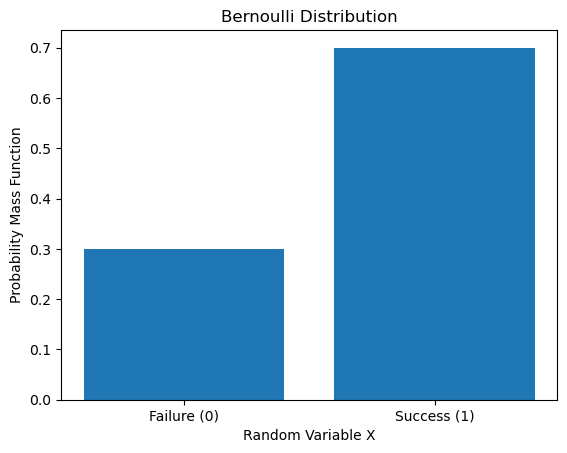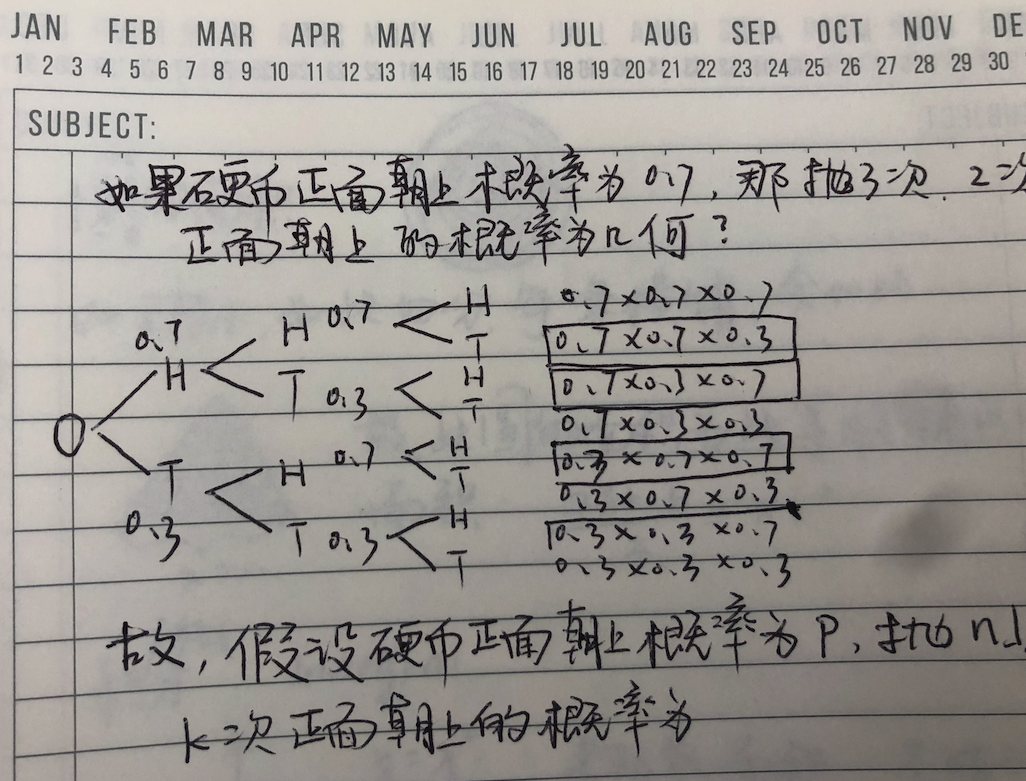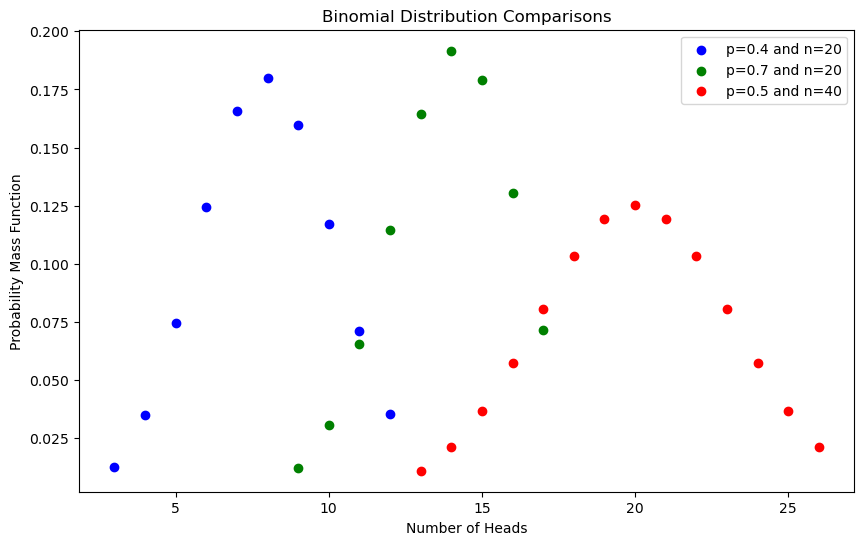
ChatGPT 画的,凑活着用。
import matplotlib.pyplot as plt
import pandas as pd
import numpy as np
from scipy.stats import binom
Bernouli Distribution #
伯努利方程描述的是「一次」「只有」「两个」可能结果之实验的结果概率。最经典的莫过于抛一次硬币,不考虑硬币立起来的情况的话,我们只有两个可能结果:正面朝上或者背面朝上。假设硬币正面朝上 ($x=1$) 的概率是 $p (0 <= p <= 1)$,那我们随机抛一次这枚硬币这一事件结果的「概率质量函数」(Probability mass function, PMF) 为:
$$f(k; p) = p^k (1 - p)^{1-k} \text{ for } k \in \{0,1\}$$
上述描述参考 Brilliant.org 及 维基百科 。
画图的话:
p = 0.7 # p when x = 1
bernoulli_values = [0, 1]
probs = [1-p, p]
plt.bar(bernoulli_values, probs, tick_label = ['Failure (0)', 'Success (1)'])
plt.title("Bernoulli Distribution")
plt.xlabel("Random Variable X")
plt.ylabel("Probability Mass Function")
# plt.savefig("/cn/blog/2024-03-23-discrete-distributions_files/bernoulli_distribution.png")

Binomial Distribution #
如果要了解 Binomial Distribution, 我们需要一些排列组合知识。
排列 Permutations #
假设一共五张牌,随机抽两张,按顺序排,共有 $5 \times (5-1) = 20$ 种排列方式。
用数学表示的话:
$$_5 P_2 = \frac{5!}{(5 - 2)!} = \frac{5\times 4 \times 3 \times 2 \times 1}{3 \times 2 \times 1} = 5 \times 4 = 20$$
组合 Combinations #
还是五张牌,随机抽两张,总共有 $\frac{5 \times 4}{2} = 10$ 中组合方式。注意,组合时两张牌有两种排列方式却只有一种组合方式。
用数学表示的话:
$$_5 C_2 = {5 \choose 2} = \frac{5!}{2!(5 - 2)!} = \frac{5 \times 4 \times 3 \times 2 \times 1}{2 \times 1 \times 3 \times 2 \times 1} = 5 \times 2 = 10$$
抛硬币 #
我们抛一枚无偏差的硬币 (fair coin),抛 3 次,一共有 8 种可能结果:hhh, hht, htt, hth, ttt, tth, thh, tht。t 表示背面朝上,h 表示正面朝上。其中,2 次正面朝上一共有三种可能 hht, hth, thh,其概率是 $3/8$。
我们不可能每次都把所有情况列举出来。其中,抛 3 次硬币,2 次正面朝上,就相当于组合,3 选 2。
$${3 \choose 2} = \frac{3!}{2! (3 - 2)!} = \frac{3 \times 2}{2 \times 1} = 3$$
所以,抛一枚无偏差硬币 n 次,其中 k 次正面朝上一共有 ${n \choose k}$ 种可能。每一种可能的概率是一样的,都是 $0.5^3$。所以「抛一枚无偏差硬币 n 次,其中 k 次正面朝上」这一事件的概率为 ${n \choose k} \cdot 0.5^3$。
这是硬币无偏差的情况。那如果是一枚有偏差 (biased) 的硬币呢?

所以,一枚有偏差的硬币,假如一次正面朝上的概率是 $p$,那么抛 $n$ 次,正面朝上 $k$ 次的概率是:
$$P_k = {n \choose k}p^k (1-p)^{n - k}$$
我们用 Python 来解释一下:
# Parameters for the binomial distributions
n1, p1 = 20, 0.4
n2, p2 = 20, 0.7
n3, p3 = 40, 0.5
# Generate the values for the x-axis
# 知道 n1, p1 之后,我们可以画出 pmf,如果是柱状图,那么所有柱子的面积和为1.
# x = binom.ppf(p, n1, p1) 算的是当 x 到多少时,之前的柱子面积和就达到了 p
# 我们用此算出 p 为 0.01 和 0.99 时的 x 值,这样对于非常不可能的 x 值我们就不用花了
# 因为其值 (pmf) 太小了
x1 = np.arange(binom.ppf(0.01, n1, p1), binom.ppf(0.99, n1, p1))
x2 = np.arange(binom.ppf(0.01, n2, p2), binom.ppf(0.99, n2, p2))
x3 = np.arange(binom.ppf(0.01, n3, p3), binom.ppf(0.99, n3, p3))
# Calculate the probabilities for each x-value
pmf1 = binom.pmf(x1, n1, p1)
pmf2 = binom.pmf(x2, n2, p2)
pmf3 = binom.pmf(x3, n3, p3)
# Create the plot
plt.figure(figsize=(10,6))
# Plot each binomial distribution
plt.scatter(x1, pmf1, color='blue', label='p=0.4 and n=20')
plt.scatter(x2, pmf2, color='green', label='p=0.7 and n=20')
plt.scatter(x3, pmf3, color='red', label='p=0.5 and n=40')
# Labels and title
plt.xlabel('Number of Heads')
plt.ylabel('Probability Mass Function')
plt.title('Binomial Distribution Comparisons')
plt.legend()
# Show the plot
plt.show()
 以上代码基本上是 ChatGPT 生成的,根据维基百科这张图
。
以上代码基本上是 ChatGPT 生成的,根据维基百科这张图
。
Poisson Distribution 泊松分布 #
平均每一分钟来 5 辆公交车 (
$\lambda = 5$),请问下一分钟来 2 辆公交车的概率是多少?
或者同样的:
中国男足队平均每场比赛进 5 个球 (请允许我再平行宇宙做一次梦),请问下一场比赛中国进 2 个球的概率是多少?
我们可以用 Binomial Distribution。我们把 1 分钟分成 60 份。以下,0 代表没有公交车来,1 表示有公交车来。这就变成了 「60 choose k」这个问题。因为平均每分钟 5 辆,所以 $p = 5/60$
$$P_k = {60 \choose k} \left(\frac{\lambda}{60} \right)^k \left(1 - \frac{\lambda}{60} \right)^{(60 - k)}$$
from matplotlib.patches import Rectangle
# Set up the figure and axis
fig, ax = plt.subplots(figsize=(12, 1))
ax.set_xlim(0, 60)
ax.set_ylim(0, 1)
# Hide the axes
ax.axis('off')
# Draw a long rectangle to represent the line
line = Rectangle((0, 0.4), 60, 0.2, linewidth=1, edgecolor='black', facecolor='none')
ax.add_patch(line)
# Choose two random parts to write '1' and have a dashed shadow
random_parts = np.random.choice(range(60), size=2, replace=False)
# Draw rectangles for each part and label them
for i in range(60):
# Determine the label for the part
label = '1' if i in random_parts else '0'
# Draw dashed shadow for parts with label '1'
if label == '1':
shadow = Rectangle((i, 0.4), 1, 0.2, linewidth=1, linestyle='--', edgecolor='black', facecolor='none')
ax.add_patch(shadow)
# Add the label below the line
ax.text(i + 0.5, 0.1, label, ha='center', va='center', fontsize=8)
# Show the plot
plt.show()
 有同学有可能会问,为什么一定是分成 60 份,我分成 10 亿份可以吗?你优秀,当然可以。
有同学有可能会问,为什么一定是分成 60 份,我分成 10 亿份可以吗?你优秀,当然可以。
我们假设一分钟分成 $n$ 份,这个问题就变成一个这样的泊松分布
:
$$ \begin{align*} P_k &= {n \choose k} \left(\frac{\lambda}{n} \right)^k \left(1 - \frac{\lambda}{n} \right)^{(n - k)} \\ &= \frac{n!}{(n-k)! k!} \cdot \frac{\lambda^k}{n^k}\cdot \frac{\left(1 - \frac{\lambda}{n} \right)^n}{\left(1 - \frac{\lambda}{n} \right)^k} \\ \end{align*} \tag{1} $$
当 $n \to \infty$ 时
$$\frac{n!}{(n-k)!} \to n^k$$
上面这个你带入 $n = 10, k = 2$ 就大致可以理解了。
$$\left(1 - \frac{\lambda}{n} \right)^k \to 1$$
根据 $e$ 的定义:
$$\left(1 - \frac{\lambda}{n} \right)^n \to e^{-\lambda}$$
将上述极值带入公式一:
$$ \begin{align*} P(X = k) &= \frac{n^k}{n^k}\cdot \frac{\lambda^k}{k!} \cdot \frac{e^{-\lambda}}{1}\\ &= \frac{\lambda^k \cdot e^{-\lambda}}{k!} \end{align*} \tag{2} $$
我们具体来看一下进 0-10 个球的概率分别是多少:
from scipy.stats import poisson
lam = 5
dist = poisson(lam)
pmfs = [dist.pmf(i) for i in range(11)]
x_axis = range(11)
plt.bar(x_axis, pmfs, color='steelblue', label=r'Poisson distribution with $\lambda=5$')
plt.xlabel("Number of Goals")
plt.ylabel("Probability Mass Function (PMF)")
plt.title(f"Poisson Distribution of Goals ($\lambda=5$)")

泊松分布的用处 #
泊松分布有什么用呢?可以用来估计 Binomial distribution 的值,特别是当 $n$ 特别大且 $p$ 非常小时。
假设一枚硬币随机抛掷一次正面朝上的概率是
$10^{-6}$,请问抛掷$10^5$次,正面朝上$100$的概率是多少?
这个问题要使用 Binomial distribution 来解的话:
$$P_{100} = {10^5 \choose 10^2}(10^{-6})^{100} (1-10^{-6})^{10^5 - 10^2}$$
这个数几乎算不出来,但我们可以用泊松分布来估计:
$$\lambda = 10^5 * 10^{-6} = 0.1$$
$$P(X = 100) = \frac{0.1^{100} \cdot e^{-0.1}}{100!}$$
这就好算多了。
#统计最后一次修改于 2025-06-03 • 编辑本页